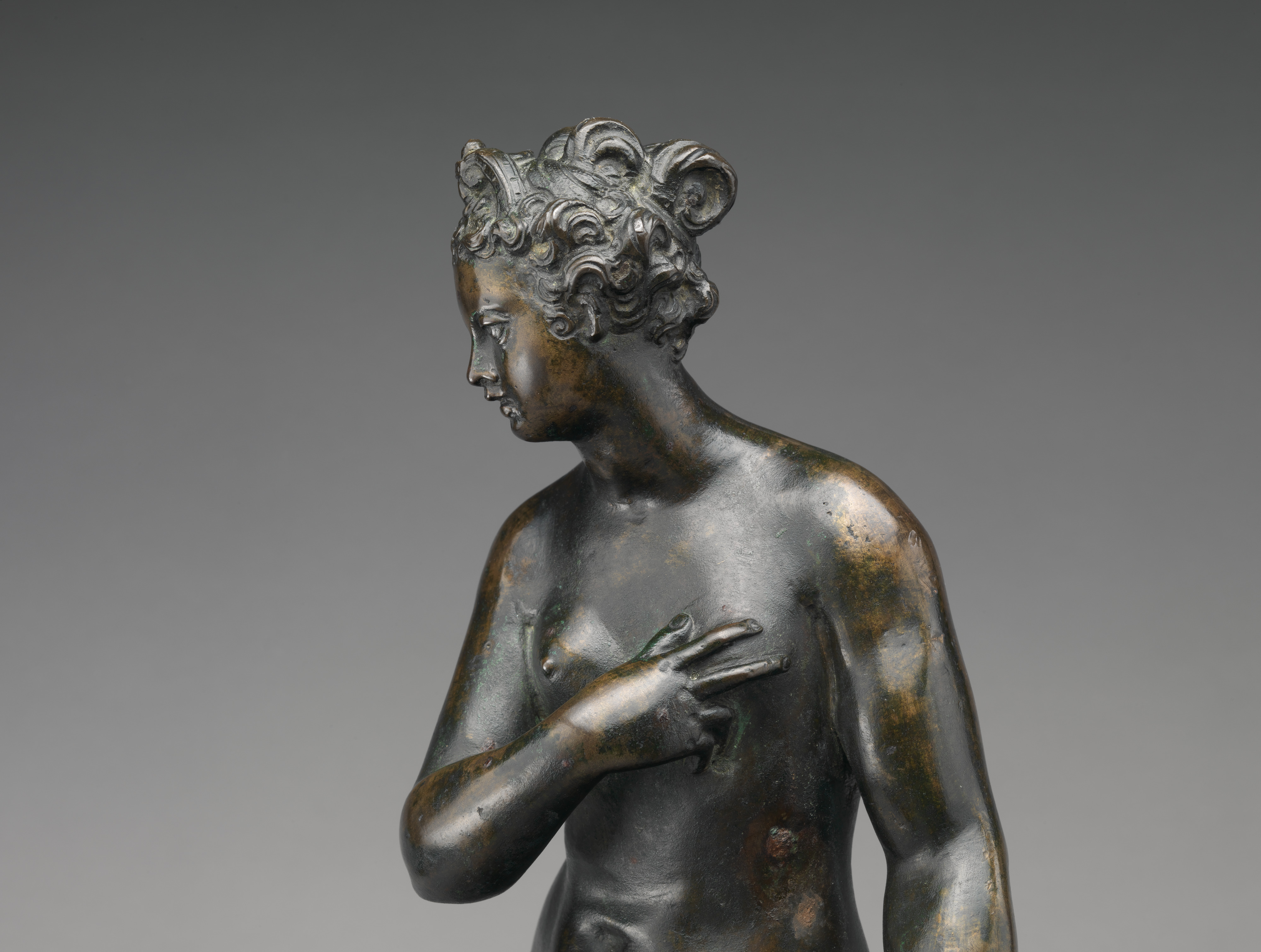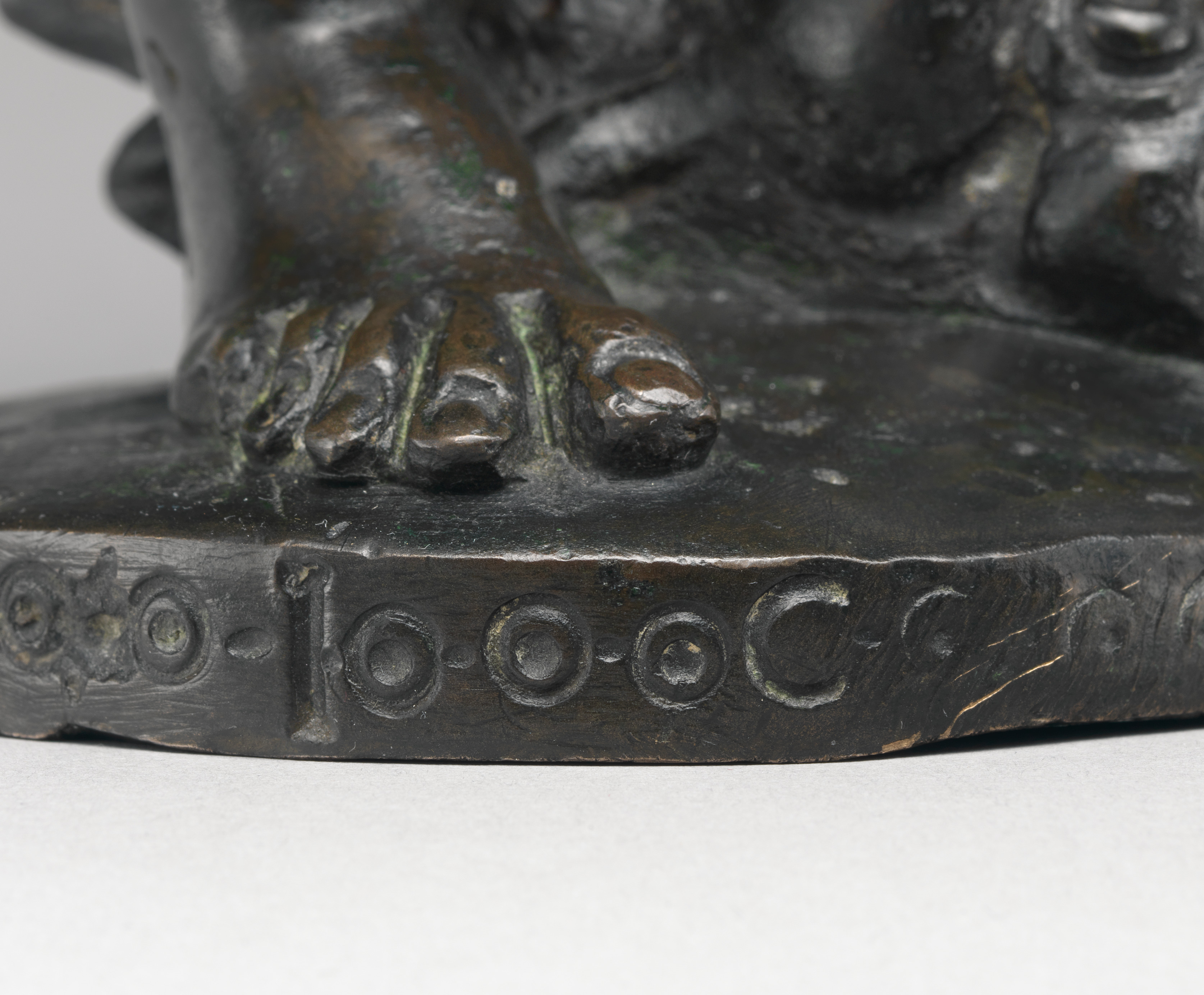Venus Marina
After a composition by Girolamo Campagna Italian
The woman, entirely nude, rests her left foot on the head of a fanciful dolphin, causing an elegant contrapposto stance of the legs that is answered by the upper body with a delicate twist. The scaly tail of the dolphin coils along the woman’s left leg so that she can hold the fin with her left hand, while her right hand gracefully covers her left breast. Head slightly inclined, she looks to her right and displays an elaborate, up-done coiffure with a diadem. The nudity and beauty of the figure identify her as Venus. The dolphin—an allusion to the birth of Venus from the sea—defines her as Venus Marina, an incarnation of the goddess as protectress of seafaring. As such, she was especially popular in Venice, where this statuette surely was made.
The figure’s composition derives from an over-lifesize statue made of Istrian stone on the balustrade of the Libreria Marciana in Venice, executed by Girolamo Campagna between 1588 and 1590 (fig. 75a).[1] This does not necessarily mean that Campagna was also the author of the statuette, for his sculptures were frequently used as models for small bronzes. His statues for the Sala delle Quattro Porte in the Palazzo Ducale, for instance, were very popular in reduced size, particularly as crowning figures for firedogs (see cat. 79).[2] The model of Campagna’s Venus Marina was also used for such functional purposes (see cat. 80) and reproduced countless times.[3] Although Campagna did execute quite spectacular monumental bronze sculpture, he seems not to have been interested in the production of small bronzes, and his involvement in the making of reductions is doubtful.
Not surprisingly, the many existing versions of the Venus Marina model vary greatly in quality (see cat. 76). They have been attributed not only to Campagna, but also to Tiziano Aspetti, reflecting the uncertainties concerning the production of small bronzes in Venice.[4] The Met’s Venus Marina stands out among these replicas not only for its quality, but also its peculiar “signature” on the base: little double circles and dots between which the letters “I” and “C” are punched (fig. 75b). The same letters can be found on six other bronze statuettes, namely an Apollo in the Bode-Museum,[5] marked “OICF” (the additional “O” and “F” most likely stand for opus and fecit, or—since these words are an uncommon combination—fusit); another Apollo in the Museum August Kestner, Hanover, marked “ICF” (the additional “F” probably again meaning fecit);[6] a so-called Saturn formerly in the Abbott Guggenheim collection, New York, marked “IC”;[7] a Jupiter, or rather Pluto, marked “IC,” on the art market;[8] and a pair of firedogs surmounted by Venus with Cupid and an Adonis, both stamped “ICF” and also on the art market.[9] In regard to the Berlin Apollo, Julius von Schlosser rather ingeniously read “IC” as the initials of the French founder Jean Chenet, who appears on the signature of the so-called paliotto in San Moisè as IOANNES CHENET.[10] However, Chenet was apparently not a caster but a chaser, the technician who may be considered the least important in the production of Venetian bronzes, which are much rougher than Florentine ones.[11] This casts doubt on whether Chenet would have signed anything alone. Leo Planiscig interpreted “IC” as the abbreviated signature of Girolamo Campagna, whose first name could be spelled as IERONIMUS, although the scholar conceded that it might also stand for Campagna’s younger brother and collaborator Giuseppe, whose Latinized name would be IOSEPHUS.[12] The notion that “IC” represents the initials of Girolamo Campagna was later endorsed by Hans Weihrauch, while other scholars preferred to see the initials as those of the caster.[13]
Peta Motture suggested that this caster might be identified as Giacomo (or Iacomo) Calderari, a bell maker and bronze caster who operated a foundry at the sign of San Francesco in Calle dei Fabbri from at least the early 1590s until 1622.[14] A surviving inventory of Calderari’s workshop shows that he produced bells, candlesticks, mortars, andirons, and bronze statuettes.[15] Although he seems to offer the perfect solution to the “IC” mystery, Motture advised caution, since there may have been other casters with the same initials who could serve as candidates, a caveat on which Victoria Avery has elaborated with much insight.[16] There is thus no proof that Calderari made the “IC” bronzes, but the fascinating inventory of his workshop does demonstrate that private foundries such as his must have been responsible for many, if not most, of the small bronzes produced in Venice.
The meaning of the letters “IC” remains an unsolved riddle. To complicate the matter further, one has to consider that there exist many casts of the “IC” models without these initials, while the differences in the workmanship of the statuettes marked “IC” suggest that they were not all made by the same hand. The treatment of their draperies, hands, and feet is quite different, as are the type and placement of the punch marks. The Apollo in Berlin and the Abbott Guggenheim “Saturn” share the same kind of alternating dots and tiny stars on the rim of their round bases as well as on their shoulder straps. The Pluto and Adonis are not only accompanied by the same type of dog, the closely placed dots on their shoulder straps appear to be identical as well. The punch marks on the Apollo in Hanover, on the other hand, are dots with large spaces between them, while those on our Venus Marina cannot be compared to any of the others.
As Avery has pointed out, the statuettes marked “IC” are all based on larger Venetian sculptures, above all on some of those on the balustrade of the Libreria Marciana.[17] Although the bronzes are not always exact replicas, it is clear that the inspiration for their compositions derives from statues created by different sculptors, such as Jacopo Sansovino, Camillo Mariani, and Agostino Rubini, which means that “IC” cannot refer to Girolamo Campagna as original designer of the model, since his work was not the only one that was copied. It is thus merely a coincidence that The Met’s Venus Marina is based on a statue that was actually executed by Campagna. It is, however, the most exact rendering of the prototype and also—despite her poorly articulated hands and feet—the most attractive figure of the entire “IC” group. It was probably intended, like most of these statuettes, to be the surmounting figure on a firedog. In a time before modern copyright laws, inventions such as Campagna’s Venus Marina for the Libreria Marciana became common properties that apparently were reproduced by different private foundries in Venice for a long time. Our Venus Marina is certainly among the better products of this industry.
-CKG
Footnotes
(For key to shortened references see bibliography in Allen, Italian Renaissance and Baroque Bronzes in The Metropolitan Museum of Art. NY: The Metropolitan Museum of Art, 2022.)
1. The balustrade of the Libreria Marciana is decorated with thirty statues by different sculptors, including Campagna, Tiziano Aspetti, Agostino and Virgilio Rubini, Bernardino Quadri, Francesco Caracca, and Camillo Mariani (see Ivanoff 1964). Campagna produced seven statues for the balustrade; see Timofiewitsch 1972, pp. 252–53. The Venus Marina is placed on the right end of the side facing the Molo, next to the obelisk marking the corner.
2. For the Quattro Porte statues, see Timofiewitsch 1972, pp. 248–49.
3. For a list of known replicas, see Bacchi in Bacchi et al. 1999, p. 410.
4. For Campagna attributions, see Weihrauch 1967, pp. 157–58; Binnebeke 1994, pp. 64–65, no. 10; Krahn 2003, p. 26. For Aspetti, see Planiscig 1921, p. 581; John Pope-Hennessy in London 1961, cat. 166; Mariacher 1971, p. 38, no. 144; Banzato and Pellegrini 1989, p. 95, no. 72.
5. Krahn 2003, pp. 144–46, cat. 36.
6. Hentzen 1955, p. 186.
7. Camins 1988, pp. 54–56, cat. 16; Schwartz 2008, p. 111, no. 53; Christie’s, New York, January 27, 2015, lot 45, which was not sold. The identification of the figure, which has no defining attributes, is based on its “prototype” (in reverse), the Saturn by Agostino Rubini on the balustrade of the Liberia Marciana.
8. Christie’s, London, November 20, 1967, lot 167. The statuette, called in the auction catalogue Jupiter, is accompanied by a dog of the same type seen with the Adonis paired with Venus, a couple that can be found on numerous firedogs. Although this friendly animal hardly looks like Cerberus, this is what it presumably must be, so the elderly man can be interpreted as Pluto. For a similar but not identical model that can be clearly identified as Jupiter because of the accompanying eagle and the thunderbolt in the figure’s right hand, see cat. 86.
9. These firedogs are mentioned in Camins 1988, p. 56 n. 8, as having been sold at Parke-Bernet, New York, June 27–28, 1962, lot 201, and are the same ones mentioned in Motture 2003, p. 284, fig. 14, as having once been in the collection of Kerin and Francis Stonor. Motture (p. 282) rightly pointed out the problem in identifying the male figure, which has been called both Adonis and Meleager.
10. Schlosser 1910, p. 8.
11. The inscription on the paliotto (see cat. 66, note 7) calls Chenet cusor (embosser) and perfector (finisher), two terms that describe the craftsman (usually a trained goldsmith) who does the cold work, that is, the chasing and cleaning of a cast. In 1642, Chenet appears in the same capacity, namely as chaser, who was commissioned together with his companion Marino Feron to clean the two angels on the high altar of San Giorgio Maggiore in Venice, modeled by Sebastiano Nicolini and cast by Pietro Boselli; see Kryza-Gersch 2008, p. 262, and V. Avery 2011, p. 468, doc. 31.
12. Planiscig 1921, pp. 542–43. Campagna signed the statues in the Sala delle Quattro Porte with “I.C.V.F.,” standing for IERONIMUS CAMPAGNA VERONENSIS FECIT. However, this signature is an exception because usually Campagna signed as HIERONIMVS, as pointed out in Timofiewitsch 1972, pp. 23–24 n. 83.
13. Weihrauch 1967, p. 158; Timofiewitsch 1972, pp. 23–24 n. 83; Camins 1988, p. 54; Krahn 2003, p. 146.
14. Motture 2003, pp. 283–84. For Giacomo Calderari, see V. Avery 2011, pp. 38, 129, and V. Avery 2013.
15. For the complete inventory, see V. Avery 2011, pp. 460–64, doc. 298 (particularly the listing of the merchandise on pp. 461–62).
16. Motture 2003, p. 304 n. 40; V. Avery 2013, pp. 246–47.
17. V. Avery 2013, p. 246.
Due to rights restrictions, this image cannot be enlarged, viewed at full screen, or downloaded.
This artwork is meant to be viewed from right to left. Scroll left to view more.




